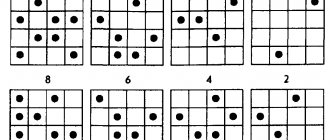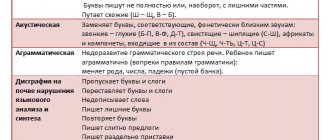Correction of writing disorders. consultation on the topic
This article provides recommendations to parents on the prevention and correction of writing disorders in younger schoolchildren, and proposes a set of exercises that, taken together and individually, will best affect the child’s writing and overall performance at school.
As they begin school, some children suddenly develop difficulties with reading and writing. The guys find themselves at odds with the Russian language, although they do well in mathematics and other subjects where, it would seem, more intelligence is required. Such children are referred to a speech therapist, who, after a thorough examination, comes to the conclusion that the child has dysgraphia - a partial specific writing disorder.
Let's look at the student's notebook. The following types of errors indicate the presence of dysgraphia:
- Errors in stressed syllables, for example, “joy” instead of “joy”.
- Skipping letters.
- Missing words and letters. For example, “staka...” instead of “stakaN”
- Rearrangement of syllables. For example, “yabkolo” instead of “apple”.
- Repeating the same letter. For example, “MagaziM” instead of “shop”.
- The letters “b”, “c”, “e”, “z”, the numbers “4”, “3”, “5” are turned to the other side (mirror writing).
- Forgetting and skipping rarely encountered letters (“ъ” and “е”).
- The child “does not notice” the margin and continues to write to the very edge of the notebook.
- “Moves out” from the lines towards the end of the sentence.
- Shifts words at random
- Often leaves no spaces between words.
- Doesn't notice the end of the sentence, doesn't put a period, and continues to write the next one with a small letter.
Parents need to pay special attention to these mistakes if:
- your child is left-handed;
- he is a converted right-hander;
- the child attended a speech therapy group;
- two or more languages are spoken in the family;
- your child went to school too early (learning to read and write unjustifiably earlier sometimes provokes the occurrence of dysgraphia and dyslexia.) This happens in cases where the child has not yet reached the psychological readiness for such learning;
- your child has problems with memory and attention.
Some tips for parents:
- If your child is assigned to read a text at home or write a lot, then break the text into parts and complete the task in several steps.
- Do not force your child to rewrite homework many times; this will not only harm the child’s health, but also instill in him insecurity, and also increase the number of mistakes.
- Praise your child for every success achieved, humiliate him as little as possible.
- Let the child play enough in childhood. Research results show that out of 100% of children with problems in the Russian language, 95% do not know how to play role-playing games, do not know the rules of even the most famous children's games, such as hide and seek and tag. In games, you need to follow the rules, so the baby learns to voluntarily regulate his actions and behavior. But it is voluntary regulation that underlies competent writing.
- Walk with your child more often. During walks, the brain is saturated with oxygen and its performance improves. Which is also very useful for successful learning.
- Enroll your child in a sports section or dance class. Sport perfectly teaches voluntary regulation, develops motor skills, develops attention and reaction speed. And deep breathing during training saturates the subcortex with oxygen.
- Playing music, in particular playing the piano, develops hand motor skills and improves the interaction of both hemispheres of the brain.
- After school, massage your child's cervical and occipital areas more often.
Exercises to help overcome dysgraphia.
These exercises will not eliminate the problem, but will help parents in overcoming dysgraphia and will help in working on the defect.
- Exercise "Proofreading".
For this exercise you need a book, boring and with a fairly large (not small) font. The student works every day for five (no more) minutes on the following task: crosses out the given letters in a continuous text. You need to start with one letter, for example, “a”. Then “o”, then the consonants with which there are problems, first they also need to be asked one at a time. After 5-6 days of such classes, we switch to two letters, one is crossed out, the other is underlined or circled. The letters should be “paired”, “similar” in the student’s mind. For example, as practice shows, most often difficulties arise with the pairs “p/t”, “p/r”, “m/l” (spelling similarity); “y/d”, “y/y”, “d/b” (in the latter case, the child forgets whether the tail of the circle is pointing up or down), etc. The pairs necessary for working through can be established when viewing any text written by your child. After seeing the correction, ask what letter he wanted to write here. More often than not, everything is clear without explanation.
Attention! It’s better if the text is not read (that’s why the book needs to be boring). All attention must be concentrated on finding the given shape of a letter, one or two, and work only with them.
- Exercise “Writing out loud.”
An extremely important and irreplaceable technique: everything that is written is spoken out loud by the writer at the time of writing and the way it is written, with underlining, highlighting the weak parts. That is, “More -Y-but an important reception” (after all, in fact, we say something like “LOOKING FOR AN EMERGENCY IMPORTANT PREMIERE”). The example is simpler: “ON THE TABLE WAS A JUG WITH MILK” (a jug of malak melted on the steel). By “weak beats” we mean sounds that, when pronounced in fluent speech, the speaker pays the least attention to. For vowel sounds, this is any unstressed position; for consonants, for example, a position at the end of a word, such as “zu*p”, or before a voiceless consonant, such as “lo*shka”. It is also important to clearly pronounce the end of the word, since for a dysgraphic person it is difficult to finish the word to the end, and often for this reason the habit of “putting sticks” is developed, i.e. add an indefinite number of squiggle sticks to the end of a word, which at a quick glance can be mistaken for letters. But the number of these squiggles and their quality do not correspond to the letters at the end of the word. It is important to determine whether your child has developed this habit. However, regardless of whether it exists or not, we get used to consistency and gradual pronunciation, we pronounce every word we write down!
- Exercise "Missing letters".
When performing this exercise, it is suggested to use the hint text, where all the missing letters are in their places. The exercise develops attention and confidence in writing skills.
For example:
Of course, no matter what, what Lariosik __to the hall is going to eat. In no way __l__ch__e m__f__t b__t__ n__ st__ro__e Petliura in__el__ig__n__n__y ch__l__we__ in__ob__e, but d__en__lm__n, p__d__i__av__iy cheerful on s__m__es__t p__t you__ya__ and p__sy__a__shchi__ __el__g__a__we in __es__es __t tr__ s__ov__, in particular...
- Exercise "Labyrinths". Labyrinths are good for developing gross motor skills (movements of the hand and forearm), attention, and continuous line. Make sure your child changes the position of his hand, not the sheet of paper.
- If a child misses letters, use the “Magic Dictation” exercise.
You read a sentence or part of it (3-4 words). The child taps out the syllables: ma-ma we-la ra-mu to catch the rhythm of the sentence. After that, he writes down this rhythm in the form of a dotted line, where instead of syllables there are dashes. The next step: write down each word in the form of dots, according to the number of letters in the word.
- If the child does not complete the endings, do the “Image of a Word” exercise.
Say the word and ask your child to name the word that begins with the penultimate letter of your word. Or a third from the end. Or to the letter that needs to be remembered in a dictionary word: for example, in the word ship - to the second letter. Words can be selected on one topic, for example, animals, plants - this will be good training in classification.
- If a child makes mistakes in vocabulary words, use the “Funny Cartoon” exercise.
We give the child a task: mentally compose a very funny cartoon in which the objects you name will appear in order. The child closes his eyes, and you begin to dictate vocabulary words, very clearly pronouncing all unstressed vowels, unpronounceable consonants and other difficult cases: ship, cow, ladder, basket...
He links them in his head into some funny plot, then opens his eyes and tells his cartoon. You react quickly.
After this, the child must, remembering the plot he invented, write all these words.
Then - a self-test: you give him the sample from which you dictated, and ask him to check whether he wrote correctly.
If there are mistakes, the next task is to draw the word in which the mistake was made so that it is clear what the difficulty is in this word (for example, we drew a cow on a bicycle or a cow with huge round eyes in the form of two letters O; a train station with a large letter K; staircase with the letter T).
- If a child does not remember the rules of the Russian language well, use the “Encryption” exercise.
The alphabet is written on the board, each letter corresponds to some image: a square, a triangle, a dancing man, etc. We need to write a note to a friend so that at least one word contains the rule that we are practicing.
For example, alternating ber-bir. The entire text of the note is encrypted, except for these three letters BER or BIR. The friend must understand what was written to him and respond in the same way.
- If the child does not apply the rules when writing, do the “Zoo” exercise.
Everyone sits in a circle, preferably on the carpet. Everyone chooses an animal and a symbol: for example, a lynx uses its hands to depict ears with tufts, a sparrow waves its wings with its elbows... Everyone demonstrates their movements, the rest try to remember.
The one who starts the game makes his movement, then the movement of one of the participants. He must catch this, repeat his movement and again make the movement of one of the participants. The pace gradually quickens. Anyone who makes a mistake works off the forfeit: publicly sings, dances, reads poetry, etc. This is also useful for emancipation and overcoming fear of an audience.
Dictations must be written! Only in a special way.
- Extremely slow! At the initial stage of eliminating dysgraphia, a dysgraphic applicant should spend at least half an hour writing a dictation of 50 words. Why so long? This can be seen from the following points.
- The text is read in its entirety. You can ask what spelling/punctuation this text is based on. Then the first sentence is dictated. Ask them to spell one or two difficult (or simply long) words. Do not insist, suggest, encourage the attempt to give the correct answer. Only then (after reading it twice, or even three or four times) start writing.
- The sentence is dictated in parts and written down with all the pronunciation features and punctuation marks spoken out loud.
All of the above exercises, taken together and individually, will have the best effect on the child’s writing and overall performance at school.
Methods for diagnosing dysgraphia
The key step in correcting a child's spelling problems is identifying the cause. Since most types of dysgraphia are associated with impaired perception and/or reproduction of oral speech, the first diagnostic step is to check it. A method is used to determine phonemic speech analysis skills. Tests are carried out during which the child demonstrates his abilities:
- invent words;
- select pictures whose names begin with a certain sound;
- divide sentences into phrases;
- compare words by sound composition;
- repeat some words or syllables after an adult;
- distinguish and highlight certain sounds in words.
For preschool children, there are special drawing tests, during which the speech therapist makes conclusions about his tendency to dysgraphia.
When oral speech has been studied, they move on to tests of written speech itself. The child performs different tasks: writing from dictation, rewriting text, describing from pictures, and reading written text out loud.
In addition, hearing, vision, nervous system, speech and manual motor skills are tested.
Development of sound analysis and synthesis skills
Work on developing phonemic awareness transitions into work on developing sound analysis skills. The latter is always carried out on the basis of sounds correctly pronounced by children. The main types of this work are:
isolating words from a sentence, syllables from words, and then sounds . Such an analysis should be accompanied by drawing up a diagram of the whole sentence (the long line is a sentence, the short lines are words, the smallest lines are syllables, the dots are sounds);
filling in missing letters and syllables;
selection of words by the number of syllables (one-syllable words are written in one column, two-syllable words in the other, etc.);
coming up with words for a given sound and writing them down , selecting for each word another with an oppositional sound, etc.








